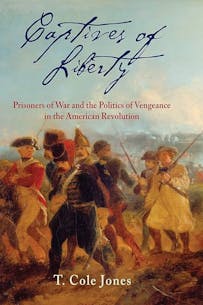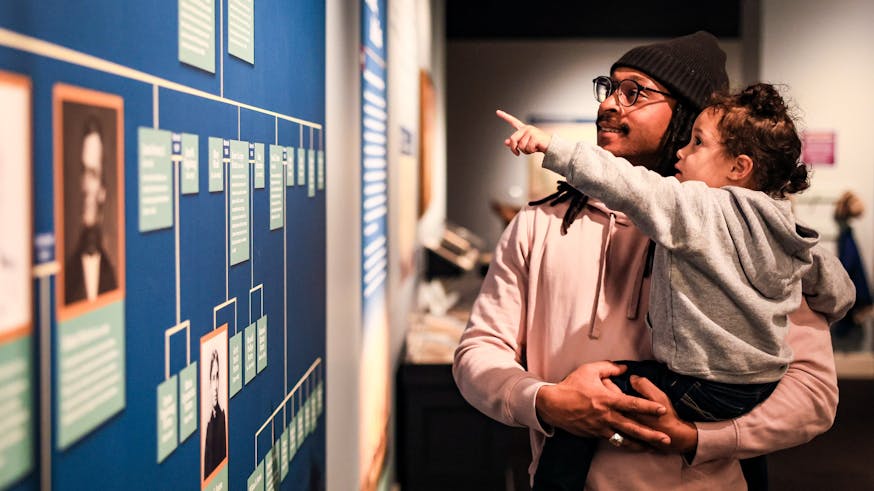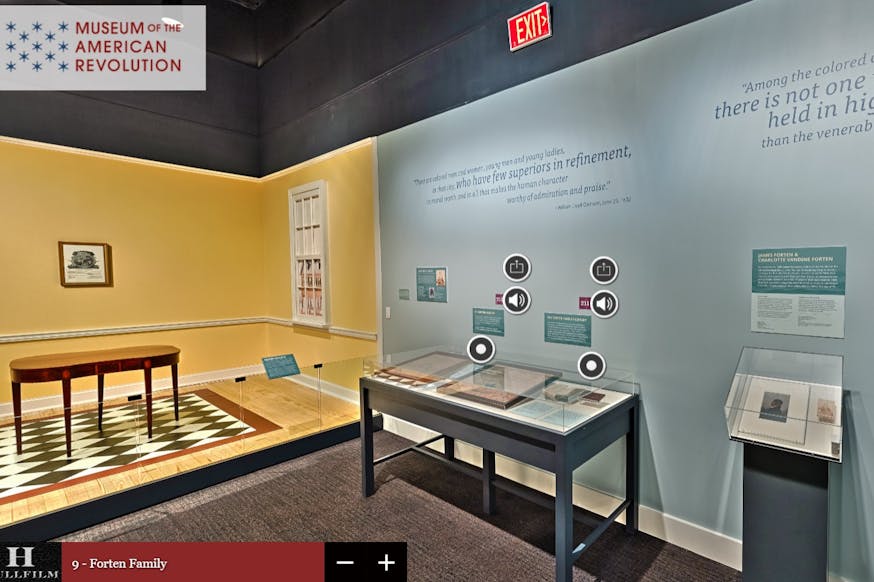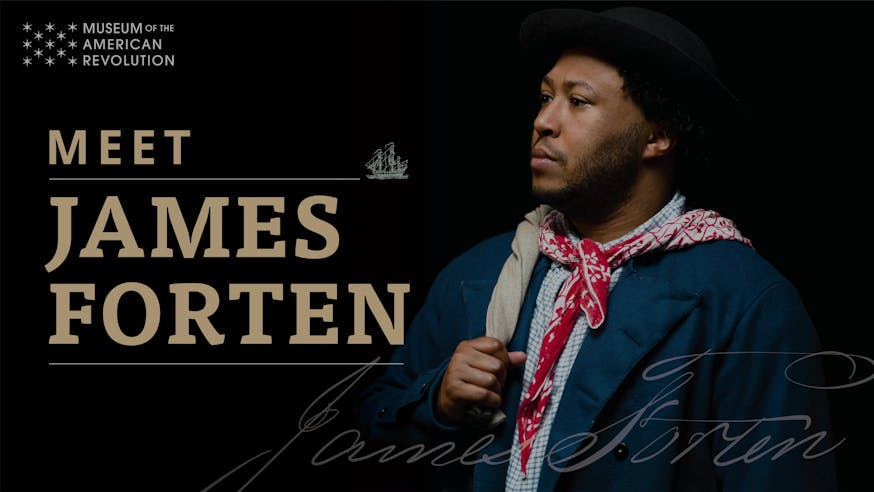Read the Revolution
Captives of Liberty
August 9, 2023
Purchase the book from University of Pennsylvania Press.
The rules of warfare drastically changed during the American Revolution. From the beginning of the war, Britain viewed the Americans as “damned rebels,” who deserved nothing more than harsh treatment if captured. George Washington, on the other hand, believed in the European custom of acting with honor in all aspects of warfare, which included treating prisoners of war fairly and with the respect their rank deserved. How could this young and inexperienced army care for enemy prisoners when they could barely care for themselves? When does the need to seek retribution on your tormentors become more important than acting with honor?
T. Cole Jones’s book Captives of Liberty: Prisoners of War and the Politics of Vengeance in the American Revolution sets out to answer those questions. Using examples from the Canadian campaign, Battle of Brooklyn, Burgoyne’s surrender at Saratoga, and the Southern campaign as case studies, Jones argues that Americans believed they were upholding European customs in their handling of prisoners of war. But when the British did not extend the same courtesies, Americans found it increasingly difficult to justify providing adequate care and respect for their enemy. “Atrocity rhetoric compounded real accounts of British mistreatment of American captives in the press,” Jones writes, which drove Americans to demand harsher treatment towards their enemies, setting off a spiral of competing violence against each other. As the war dragged on, honor was replaced with the need for revenge.
Read an excerpt detailing the conditions under which American soldiers were imprisoned by the British following defeat at the Battle of Brooklyn on Aug. 26, 1776.
Excerpt
Perched on the highest point on Manhattan Island overlooking the Hudson River, in November 1776 Fort Washington was an impressive feat of military engineering. Named in honor of the American commander, the pentagonal fortification was the Continental Army’s last hope to prevent the island from falling into British hands. Despite assiduous preparation that past summer, American forces had been unable to stop a Crown armada from landing nearly twenty-five thousand British and Hessian troops on Long Island in August. The long-feared “Armies of foreign Mercenaries” that Jefferson had decried in example of envelopment, Major General Howe defeated the Continentals on August 27 at the Battle of Brooklyn, capturing over a thousand prisoners. Washington, who had bloodlessly driven the British from Boston in March, retreated the length of Manhattan, losing men, materiel, and most of his mettle at Kip’s Bay, Harlem Heights, and White Plains. The British were unimpressed with their adversary’s haphazard and unsoldierly defense of New York. One Hessian described the American officers as “nothing but mechanics, tailors, shoemakers, wig-makers, [and] barbers,” hardly the stalwarts who had bloodied the regulars at Concord and Bunker Hill. Victory was almost too easy. Perhaps the formidable entrenchments of Fort Washington would at last offer worthy opposition.
To the horror of the American commander in chief, observing from the other side of the Hudson, they did not. Shortly before dawn on November 16, British land batteries and naval artillery erupted in “a violent Cannonade,” engulfing Fort Washington in a haze of acrid smoke punctuated by blinding illumination. Out of the fog emerged the leveled bayonets of the Hessian grenadiers, English light infantry, and Scottish Highlanders. In the face of such martial onslaught, the American outer works were quickly abandoned, rendering the fort’s position desperate. Should the enemy breach the walls, there would be little hope for quarter for the defenders within. According to a British officer present at the attack, General Howe insisted that the Americans “surrender immediately, without any other terms than a promise of their lives, and their baggage.” The American commander, Colonel Robert Magaw of Pennsylvania, “pled for the Honors of War,” but Howe would have none of it. The fort would fall; only the garrison’s fate was in question.
Sign Up
Get biweekly Read the Revolution featured excerpts right to your inbox.
The defenders lost their appetite for resistance at the sight of the oncoming Hessians. These rented soldiers had earned a reputation for brutality since their arrival that August. In the aftermath of the Battle of Brooklyn, rumors abounded throughout the Continental Army that they had refused to spare surrendering Americans. One Pennsylvania officer recalled that he was determined “to run any risk rather than fall into their hands.” The rumors carried more than a shred of truth. A Hessian officer admitted that the American riflemen killed in that battle “were mostly pitted to the trees with bayonets.” He attributed the actions of his countrymen not to any innate Germanic cruelty but to the fact that “the English did not give much quarter, and constantly urged our people to do the like.” A Scottish officer corroborated his Hessian ally’s explanation: “We took care to tell the Hessians that the Rebels had resolved to give no quarters to them in particular, which made them fight desperately, and put all to death that fell into their hands.” Because Americans were rebels and “vile enemies to their King and country,” the Scot rejoiced that “the Hessians and our brave Highlanders gave no quarters; and it was a fine sight to see with what alacrity they dispatched the Rebels with bayonets.” Magaw’s troops knew that the officers commanding the assault on Fort Washington were unlikely to intercede on behalf of men they considered to be “damned rebels.” They waited anxiously while the Continental colonel and his subordinate officers considered the British proposition.
Rather than consign his men to death, Magaw capitulated. By early afternoon, the fort’s guns fell silent, and 2,837 American soldiers laid down their arms in surrender. The garrison marched out of the fort, flanked on either side by the Hessian troops who had led the assault; exhausted and enraged at the carnage, they were in no mood for niceties. A Hessian chaplain who witnessed the surrender admitted that “despite the strictest orders, the prisoners received a number of blows.” Most of these were delivered with the butt end of a musket as the prisoner filed out of the works, but John Adlum, a Pennsylvania militiaman and survivor of the battle, remembered hearing “that some of our soldiers, was [sic] severely cut with the swords of the Hessians.” All suffered blistering insults and unabated plundering at the hands of their captors, the guarantees for their personal property in the articles of capitulation notwithstanding. British officers present at the scene did nothing to restrain their allies. At least one, General Howe’s adjutant Stephen Kemble, was shocked by the breach of the articles. “To our shame, tho’ they Capitulated for the Safety of their Baggage, they were stripped of their Wearing Apparel as they [were] Marched out by Hessians.”
Other British officers were less than apologetic. Captain Frederick Mackenzie thought the Americans “had no right to expect the mild treatment they met with.” After all, the men were “Rebels taken in arms” and thus “forfeit their lives by the laws of all Countries.” Although he was pleased to boast that “Humanity is the characteristic of the British troops,” Mackenzie expressed the prevailing opinion among his fellow officers that “we act with too much lenity and humanity towards the Rebels.” Fear of British violence should bring the upstart Americans to heel.
The Fort Washington prisoners had plenty to fear as they marched toward captivity. The specter of the hangman still loomed large in their imaginations. According to one Connecticut soldier, William Slade, their guards referred to the Americans as “Yankee Rebels a going to the gallows.” In the aftermath of Brooklyn, the captives had been similarly accosted by British “officers, soldiers and camp-ladies” in “the most scurrilous and abusive language,” demanding to know why they had not been “put to the bayonet or hanged.” No one knew what was in store for prisoners once they reached New York City.
To compound their woes, the prisoners trudged southward with empty stomachs and bare backs. The British failed to supply them with any provisions on their march, and most had been plundered of what little warm clothing they owned. William Slade spent the day after the battle “in sorrow and hunger, having no mercy showed.” In their affidavit to Congress, prisoners Samuel Young and William Houston reported that “they had no victuals given them of any kind” for three days after the surrender. Far from eliciting the sympathy of their captors, these starving, exhausted, and dejected men “excited the laughter of our Soldiers,” according to Captain Mackenzie. Many Britons, protected from the cold by their watch coats, regimentals, and woolen breeches, appeared to delight in the suffering of their prisoners, who “were in general but very indifferently clothed; few of them appeared to have a Second shirt.” The Americans were understandably less jocose. Slade aptly summarized their predicament: “These four days we spent in hunger and sorrow being decried by every one and calld [sic] Rebs.” Unless they were resupplied and properly quartered, they might have more to “dread than the common sufferings of prisoners of war.” Prayers for a speedy exchange were on everyone’s lips.
T. Cole Jones, Captives of Liberty: Prisoners of War and the Politics of Vengeance in the American Revolution (University of Pennsylvania Press, 2020), 93-96.
Tags
Learn More

Black Founders: The Forten Family of Philadelphia
February 11 - November 26, 2023
Black Founders Virtual Tour

